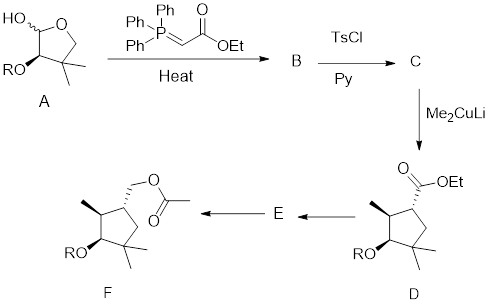
(a)
Interpretation: In the given synthetic scheme, the structures of compounds B and C have to be drawn.
Concept Introduction:
The given synthetic transformation scheme is shown here:

For any given transformation, the following mandatory observations have to be made clear to predict the synthetic scheme:
- Observe whether there is any change in the carbon skeleton.
- Observe whether there is any change in the location of the
functional group . - Predict the synthetic scheme in such a way that these two observations have to be achieved within the minimum chemo selective steps.
Tosylation reaction:
The alcohol is treated with any tosyl chloride (methane sulfonyl chloride) which yields tosylated product this reaction is called as alkyl tosylate and which is shown below,

Wittig reaction:
It is the conversion of a
General Scheme

(b)
Interpretation: The conversion C to D has to be explained.
Concept Introduction:
The given synthetic transformation scheme is shown here:

For any given transformation, the following mandatory observations have to be made clear to predict the synthetic scheme:
- Observe whether there is any change in the carbon skeleton.
- Observe whether there is any change in the location of the functional group.
- Predict the synthetic scheme in such a way that these two observations have to be achieved within the minimum chemo selective steps.
Tosylation reaction:
The alcohol is treated with any tosyl chloride (methane sulfonyl chloride) which yields tosylated product this reaction is called as alkyl tosylate and which is shown below,

Wittig reaction:
It is the conversion of a ketone or an aldehyde into alkene using the ylide of phosphorus.
General Scheme

Gillman’s reagent:
It is the organometallic reagent that will be widely used to alkylate
It is represented as
(c)
Interpretation:
- The reagents used to convert D into F have to be identified.
- The structure of E has to be found.
Concept Introduction:
The given synthetic transformation scheme is shown here:

For any given transformation, the following mandatory observations have to be made clear to predict the synthetic scheme:
- Observe whether there is any change in the carbon skeleton.
- Observe whether there is any change in the location of the functional group.
- Predict the synthetic scheme in such a way that these two observations have to be achieved within the minimum chemo selective steps.
Tosylation reaction:
The alcohol is treated with any tosyl chloride (methane sulfonyl chloride) which yields tosylated product this reaction is called as alkyl tosylate and which is shown below,

Wittig reaction:
It is the conversion of a ketone or an aldehyde into alkene using the ylide of phosphorus.
General Scheme

Gillman’s reagent:
It is the organometallic reagent that will be widely used to alkylate
It is represented as
Reduction with Lithium Aluminum hydride
Lithium Aluminum hydride reduces aldehydes, ketones and esters into alcohol.
Conversion of ketone into alcohol:

Conversion of aldehyde into alcohol:

Conversion of ester into alcohol:

Reaction of alcohol with acetic anhydride:
Alcohols react with acetic anhydride to give ester.
General scheme:

Trending nowThis is a popular solution!

Chapter 21 Solutions
ORGANIC CHEMISTRY: W/ACCESS
- Hi, I need your help with the drawing, please. I have attached the question along with my lab instructions. Please use the reaction from the lab only, as we are not allowed to use outside sources. Thank you!arrow_forwardHi, I need your help i dont know which one to draw please. I’ve attached the question along with my lab instructions. Please use the reaction from the lab only, as we are not allowed to use outside sources. Thank you!arrow_forward5. Write the formation reaction of the following complex compounds from the following reactants: 6. AgNO₃ + K₂CrO₂ + NH₄OH → 7. HgNO₃ + excess KI → 8. Al(NO₃)₃ + excess NaOH →arrow_forward
- Indicate whether the product formed in the reaction exhibits tautomerism. If so, draw the structure of the tautomers. CO₂C2H5 + CH3-NH-NH,arrow_forwardDraw the major product of this reaction N-(cyclohex-1-en-1-yl)-1-(pyrrolidino) reacts with CH2=CHCHO, heat, H3O+arrow_forwardDraw the starting material that would be needed to make this product through an intramolecular Dieckmann reactionarrow_forward
- Draw the major product of this reaction. Nitropropane reacts + pent-3-en-2-one reacts with NaOCH2CH3, CH3CHOHarrow_forwardIndicate whether the product formed in the reaction exhibits tautomerism. If so, draw the structure of the tautomers. OC2H5 + CoHs-NH-NH,arrow_forwardExplain how substitutions at the 5-position of barbituric acid increase the compound's lipophilicity.arrow_forward
- Explain how substitutions at the 5-position of phenobarbital increase the compound's lipophilicity.arrow_forwardName an interesting derivative of barbituric acid, describing its structure.arrow_forwardBriefly describe the synthesis mechanism of barbituric acid from the condensation of urea with a β-diketone.arrow_forward
 ChemistryChemistryISBN:9781305957404Author:Steven S. Zumdahl, Susan A. Zumdahl, Donald J. DeCostePublisher:Cengage Learning
ChemistryChemistryISBN:9781305957404Author:Steven S. Zumdahl, Susan A. Zumdahl, Donald J. DeCostePublisher:Cengage Learning ChemistryChemistryISBN:9781259911156Author:Raymond Chang Dr., Jason Overby ProfessorPublisher:McGraw-Hill Education
ChemistryChemistryISBN:9781259911156Author:Raymond Chang Dr., Jason Overby ProfessorPublisher:McGraw-Hill Education Principles of Instrumental AnalysisChemistryISBN:9781305577213Author:Douglas A. Skoog, F. James Holler, Stanley R. CrouchPublisher:Cengage Learning
Principles of Instrumental AnalysisChemistryISBN:9781305577213Author:Douglas A. Skoog, F. James Holler, Stanley R. CrouchPublisher:Cengage Learning Organic ChemistryChemistryISBN:9780078021558Author:Janice Gorzynski Smith Dr.Publisher:McGraw-Hill Education
Organic ChemistryChemistryISBN:9780078021558Author:Janice Gorzynski Smith Dr.Publisher:McGraw-Hill Education Chemistry: Principles and ReactionsChemistryISBN:9781305079373Author:William L. Masterton, Cecile N. HurleyPublisher:Cengage Learning
Chemistry: Principles and ReactionsChemistryISBN:9781305079373Author:William L. Masterton, Cecile N. HurleyPublisher:Cengage Learning Elementary Principles of Chemical Processes, Bind...ChemistryISBN:9781118431221Author:Richard M. Felder, Ronald W. Rousseau, Lisa G. BullardPublisher:WILEY
Elementary Principles of Chemical Processes, Bind...ChemistryISBN:9781118431221Author:Richard M. Felder, Ronald W. Rousseau, Lisa G. BullardPublisher:WILEY





